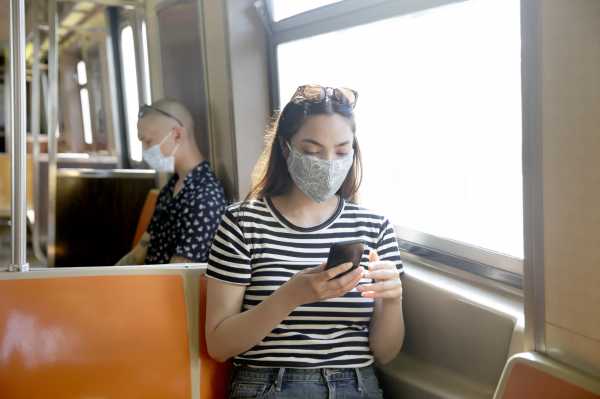
This story is part of a group of stories called

Uncovering and explaining how our digital world is changing — and changing us.

It may have gotten off to a slow start, but digital Covid-19 contact tracing apps are finally picking up steam in the United States — and may have surmounted one of their biggest obstacles to widespread use.
States are now able to create contact tracing apps that work with those from other states, thanks to a national server that works with the exposure notification tool developed by Apple and Google and stores information about potential exposures from all states that use it. This gives us the potential for a nationwide digital contact tracing system. Some states are already incorporating this technology into their regional efforts: the latest are New York and New Jersey, which unveiled new apps on Thursday.
While the national server has been around for a few months, the fact that a growing number of states are using it is a big deal. Because America’s federal government refuses to create a national contact tracing app, each state has so far needed to create its own, leading to a patchwork of apps across the country that used different technologies and couldn’t communicate with each other. Any given state app became effectively useless as soon as the device it was on crossed a state line.
This is no longer the case. Some states — New Jersey, New York, Pennsylvania, and Delaware — have teamed up to form a regional alliance of apps with a common codebase. That means if you had the New York version of the app and traveled to New Jersey for a large, crowded superspreader event where you were exposed to the coronavirus, you’d still get a notification (assuming the infected person used one of those states’ apps and reported their positive results to the proper health authorities).
The public health authorities behind these new digital contact tracing apps are using the Apple-Google exposure notification tool, which uses Bluetooth to exchange anonymous “keys” with any devices that come within a certain proximity (and have opted into the tool). If someone tests positive for the coronavirus, their keys are uploaded to a server. Individual devices check the server every day, and if any keys on the server match keys received by the device, it will alert its owner that they may have been exposed to the virus.
Apple and Google worked together to make the tool interoperable with iOS and Android operating systems, and iOS 14 has the exposure notification tool baked into the system itself and notifies users about the feature, creating a relatively seamless process to enable it. While a contact tracing app doesn’t have to use the Apple-Google tool — in fact, some states and countries have elected to go their own way here — those apps have had technical and privacy issues, and can’t work with each other.
The Association of Public Health Laboratories launched the new national key server in July specifically for the Apple-Google tool, which means any state apps that use the tool and this national server will basically work together. If someone with Wyoming’s app tests positive, their keys are uploaded to a server and can be accessed by devices using apps from Delaware, New Jersey, New York, North Carolina, North Dakota, Pennsylvania, and parts of California that are participating in a pilot program.
Several other states, including Alabama, Nevada, Virginia, and the territory of Guam, are also using the Apple-Google exposure notification tool in their contact tracing apps, but they are not using the national key server. A few more — Colorado, Connecticut, Maryland, Oregon, Washingtons state, and Washington, DC — have announced plans to come out with their own apps powered by the Apple-Google tool.
New Jersey and New York are the newest states to roll out their apps. Along with Pennsylvania and Delaware, they’re touting a sort of regional effort at contact tracing. They’re using the national server, and the four apps are all very similar, from their name (“COVID Alert [state]”) to their source code: The apps were built using an open source codebase called COVID Green, which was initially developed for Ireland’s app. That gives all four apps a uniform look and function, and it means the process of building them was relatively fast compared to the time it would have taken for each state to build their own app from scratch.
The states were also assisted by the Linux Foundation Public Health (LFPH) initiative, which works with public health authorities to use open source software to fight the coronavirus.
“We’re really focused on making sure to build out an ecosystem around exposure notification, and making sure that there’s open source options in order to get these apps out more quickly,” Jenny Wanger of LFPH told Recode. “And to make sure that they’re secure and trustworthy, as well as building a community for everybody who’s actually implementing these apps.”
One testament to how the attitude toward digital contact tracing and the Apple-Google exposure notification tool in particular has changed: In May, Pennsylvania told Recode it was using a different digital contact tracing tool to assist human contact tracing efforts, while New York told Recode it was focusing on building its manual contact tracing program.
Apple and Google also recently announced an “exposure notification express” option that allows states to enable exposure notifications without having to build a standalone app. Several states that are part of the so-called Western States Pact — Washington, Oregon, and California — are currently piloting projects based on the exposure notifications express technology.
The new apps and region-wide efforts come at a time when there’s an increased awareness of and interest in contact tracing, and when infection rates are relatively low but could be on the verge of a fall spike — meaning contact tracing could come in handy very soon. As always, the effectiveness of the apps depends on how many people use them. With states working together, new technology allowing apps to work across state lines, and the device operating system updates in place that facilitate their use, we’re as close as we’ve ever been to having a nationwide digital contact tracing effort.
Open Sourced is made possible by Omidyar Network. All Open Sourced content is editorially independent and produced by our journalists.
Help keep Vox free for all
Millions turn to Vox each month to understand what’s happening in the news, from the coronavirus crisis to a racial reckoning to what is, quite possibly, the most consequential presidential election of our lifetimes. Our mission has never been more vital than it is in this moment: to empower you through understanding. But our distinctive brand of explanatory journalism takes resources. Even when the economy and the news advertising market recovers, your support will be a critical part of sustaining our resource-intensive work. If you have already contributed, thank you. If you haven’t, please consider helping everyone make sense of an increasingly chaotic world: Contribute today from as little as $3.
Sourse: vox.com






